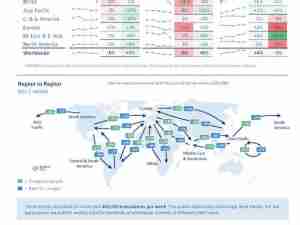U.S. aviation regulators say they’ve made progress reducing the risk of flight disruptions from new 5G service that’s set to start Jan. 19, but are still releasing scores of potential limitations across the country.
The Federal Aviation Administration expects to provide information soon on what percentage of aircraft will be subject to the restrictions, the agency said in an emailed statement Wednesday. At midnight, it will release so-called notices to air missions or Notams spelling out new prohibitions at hundreds of sites.
The FAA “has made progress to safely reduce the risk of delays and cancellations as wireless companies share more data and manufacturer altimeter testing results arrive,” the agency said in the release.
AT&T Inc. and Verizon Communications Inc. reached a compromise with U.S. officials last week, agreeing to delay their 5G service for two weeks and to limit placement of cell towers near 50 airports for at least six months. While the companies have said their new service poses no risk to aviation, the FAA and aerospace-industry groups say tests show devices that calculate altitude could become unreliable if aircraft get too close to cell towers.
Even with the last-minute agreement, the FAA has warned that the risks the new, faster service will interfere with aircraft equipment requires them to enact limitations until it can be assured that operations will be safe.
The FAA said Wednesday that in at least some cases, the restrictions would be less than it had anticipated in a directive issued last month.
One type of GPS-assisted landing that it had earlier warned might no longer be permitted will be possible at certain airports, the FAA said.
After studying detailed information about where the wireless companies expect to place 5G towers, the FAA also determined that landings will be permitted without restrictions at some airports. The agency said it may have to enact limits at those airports as 5G is deployed more widely.
The broad impacts on airlines, helicopters and private jets remain unclear. If aircraft manufacturers can show that devices known as radar altimeters are shielded from the new 5G signals, they may face no restrictions, the FAA said.
Manufacturers can apply for what is known as an “alternative means of compliance” that could allow exemptions to some or all of the FAA’s restrictions. The FAA must approve each such application individually.
The most likely flight limits on airlines will be restrictions on low-visibility landings at runways near 5G towers, the FAA said.






